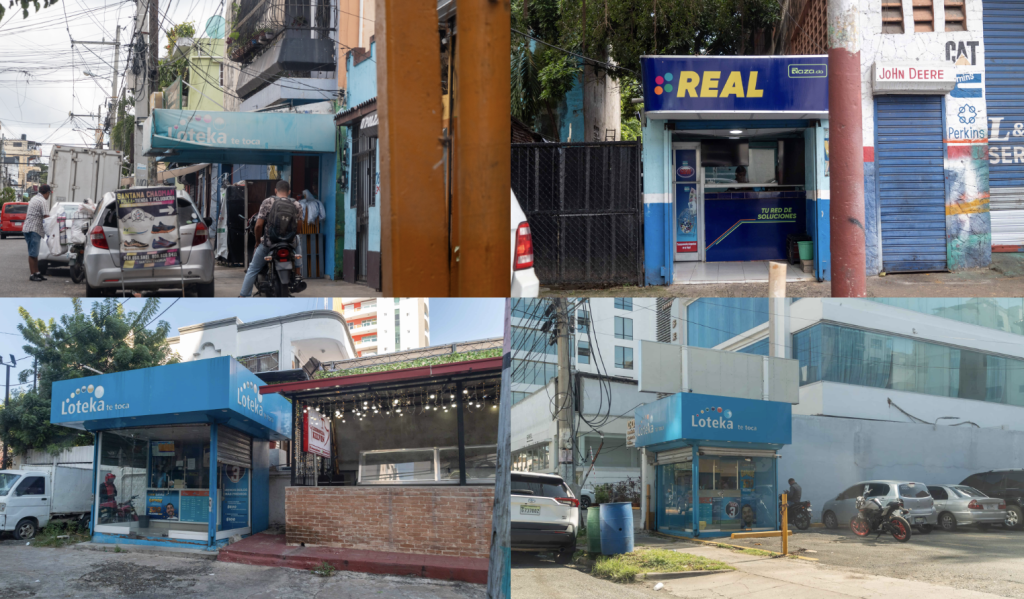
Santo Domingo is grappling with escalating visual contamination and urban disorder, fueled by the relentless proliferation of lottery booths (bancas de loterías) across its streets and avenues. Diario Libre’s Adalberto de la Rosa reports that these small, highly-visible businesses are not only cluttering the capital city’s aesthetic but are also, in many cases, outright violating municipal regulations regarding spacing and the crucial use of public sidewalks. The newspaper highlights that city ordinances are ignored by lottery booth owners.
The consortia that run this line of business are now ubiquitous, setting up shop in small, brightly colored spaces everywhere in the capital city and the provinces. Their presence is felt from rich to poor neighborhoods. He writes about their proliferation in the exclusive residential zones like Piantini, Renacimiento, La Esperilla, Los Prados, and La Castellana, to major thoroughfares including Abraham Lincoln, Winston Churchill, Máximo Gómez and Sarasota.
Middle-class neighborhoods, including Gascue, Ensanche Espaillat, Evaristo Morales, and the Colonial City, are also saturated by the betting shops. However, the most significant concentration of these operations is found in marginalized sectors such as Gualey, Los Guandules, Capotillo, and Cristo Rey, further stressing already chaotic urban environments.
Diario Libre highlights that the scale of this industry is staggering. It is estimated that there are over 150,000 lottery booths nationwide, with a high density clustered within the National District. A key issue is the blatant disregard for standards governing the distance between booths and, critically, their setback from pedestrian areas, which legally varies from 0.50 meters to four meters depending on the location.
A recent survey conducted by Diario Libre across avenues and residential areas confirmed widespread non-compliance with Ordinance 1-2021. This regulation was designed to establish a compact, sustainable, and livable city model, emphasizing respect for public spaces and the integrity of the urban street network.
Diario Libre reports that the core of the problem lies in the flagrant obstruction of pedestrian rights-of-way. Article 6 of the universal urban norms for the National District explicitly states:
“The paved part (of the sidewalks) shall be free of obstacles and interruptions, with a concrete, non-slip, and high-albedo riding surface… finishings with other materials are only permitted for horizontal signage or in areas designated for motor or visual disability.”
However, numerous booths are observed breaking the official sidewalk design. Owners often install unauthorized, and sometimes slippery, mosaics or tiles to “beautify” their storefronts. In other cases, they illegally raise the level of the sidewalk, creating uneven surfaces that actively obstruct traffic for pedestrians, especially those using wheelchairs or with mobility issues.
Accidents are a common consequence, with pedestrians stumbling over the varying levels or slipping on the inadequate floor materials.
Further compounding the violations, some booths feature roofs or structural elements that protrude into and invade the airspace above the sidewalks, in direct violation of Resolution 1-2021. This regulation prohibits any fragmentation, change of pavement, elevation, or inclination of sidewalks in front of property access points to guarantee a homogenous and safe pedestrian path.
Proximity bans ignored
Diario Libre reports on how the chaos extends to sensitive areas. Regulations strictly prohibit the installation of lottery booths near public schools, private colleges, hospitals, churches, and child care centers. Yet, the investigation found several establishments positioned adjacent to or even sharing walls with educational institutions.
While Resolution 005-2019 eliminated an older requirement for a minimum 200-meter distance between booths, the current situation remains a textbook example of disorder. On Francisco Villaespesa street in Villa Juana, for instance, a single consortium, “Banca Real,” operates six locations on the same sidewalk in a space of less than 400 meters. Adding to the sense of urban anarchy, another booth was found operating directly beneath a pedestrian bridge on the Expreso V Centenarios avenue.
The story appears as Diario Libre continues to report on violations of the law and lack of enforcement of the law by the government itself. Executive Editor Anibal de Castro urges the government to strengthen local institutions.
Read more in Spanish:
Diario Libre
Diario Libre editorial
20 November 2025

